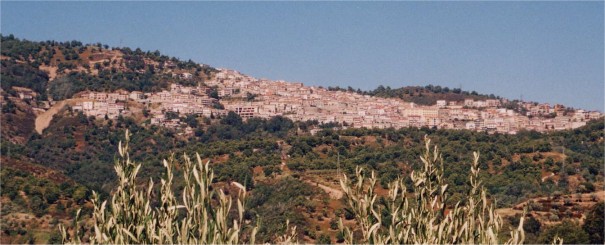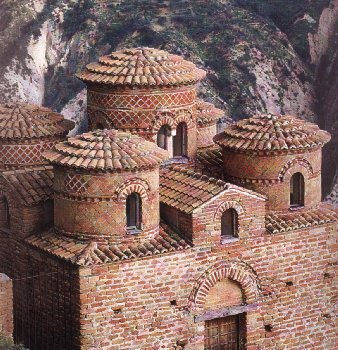
Immigrants from Calabria to The United States:
Noting the Albany, NY, Presence.
by
James C. Mancuso
Los Angeles, CA
When a person travels around Calabria, or looks at a map of Calabria, three geographical features
stand out -- the length of the coastline that surrounds the province, the mountains that cover the
entire peninsula, and the central location of Calabria in the Mediterranean. All three of these
features eventually contributed to helping to motivate hundreds of thousands of Calabria's people
to immigrate to The United States of America.

A glance at the photo of the mountain town of Sersale, above, shows a village that is occupies the crest of a mountain, as is common allover the Italian peninsula. The people of Calabria, like the people of other villages, built their villages in this way for three reasons -- building the village high on a mountain took the population away from the malaria-ridden lowlands, the high position offered protection from raiders and warring conquerors, and by building on a mountain top valuable growing land in the valleys could be conserved.
By living in the protected villages the people lived at an altitude that was too high for the mosquitos which infested the lowlands. In that way, they could avoid getting the malarial fevers which the mosquitos transmitted. But, the people still needed to go to the lower levels to work the areas which could be devoted to agriculture. So, the laboring agricultural workers did not escape the mosquitos, and malaria was common in the region.
With the very long coastline which surrounds Calabria, it was very easy for the ships of
pirates and of conquering invaders to land fighting forces. To fight off these forces, the people
built the villages in a position that allowed them to gather in the town to seek protection. Walls
around the towns, coupled with strong defensive castles
provided the people some protection from slave traders and other invaders.
(Sersale, above, was never surrounded by walls. The town was founded relatively late
in Italy's history. The people of a neighboring town, Serrastretta, received permission
from the ruling baron, Francesco Sersale, to move their home to the present location of
the town to which they gave the baron's name.)
leave Even inland towns were constantly under threat of piracy and invasion. Calabria
is located in a central position in the Mediterranean. Bands of enterprising raiders regularly
pillaged the towns. The remains of the many people who fought over and then ruled Calabria are to be found
all over the peninsula. For example, the Byzantine Emperors, who ruled from the city that is now
Constantinople, nominally controlled Calabria from the IVth Century up until about 1050 A. D., at
which time the Norman knights came down from Normandy and systematically took over the
entire area south of Rome, including Sicily. The presence of the Byzantine Culture is to be seen
in the beautiful little Xth Century chapel, known as La Cattolica (pictured below) that is
located at Stilo.

The last government to be established to control Calabria was put into place in 1860, when Garibaldi and his Red Shirts swept through the region . After Garibaldi had successfully driven out the repressive, ineffective Bourbon Monarchy, he turned the control of the region over the King Victor Emmanuel, the ruler of Savoy, who became the King in the constitutional monarchy that was the base of the government that became the modern republican government of Italy.
After Calabria was incorporated into modern Italy, the problems of life in Calabria became even more intensified. The central government imposed heavy taxes on the people. The nobility fought every measure that would have reduced their power and would have given the people more opportunity to control their own lives. Meanwhile, the new government conscripted the young men of the hapless population to serve as soldiers in the armies sent abroad in the misguided effort to gain a colonial empire. The little industry that had flourished in the area declined to even lower levels. Young men could escape these conditions by joining bands of brigands that could easily escape the law by taking refuge in Calabria's rugged mountains.
This misery coincided with fast-developing events in The United States of America. There industry flourished after the civil war brought about a stronger central federal government. The country needed vast numbers of unskilled and skilled labor. The Calabrese were willing to take up the opportunities offered by the industrial revolution in The USA. Hundreds of thousands of the Calabrese made their way to Naples to find passage to The USA.
The majority of the Calabrese immigrants to The USA settled in the industrial northeastern part of the country. It can be said, "They followed the railroads." Railroad companies offered work. The railroads connected the cities in which work was to be found.
The Capital District of New York State was a major railroad hub. The Calabrese came to
The Capital District. As was usual, the people from a particular region in Italy tended to find
each other in settlements in The USA. Thus, the majority of the Calabria-to-Albany immigrants
came from the Ionian Coast -- The sole of the Italian boot. They came from towns like Locri,
Crotone, Siderno, etc. They established their homes in the area of Albany known as The South
End. There they formed a thriving community, complete with import stores, bakeries,
restaurants, Saint Anthony's church, and the Sons of Italy Hall. The community had been
dispersing during the 1950 decade, but its total demise was assured when Governor Nelson
Rockefeller put into effect his grand vision of a major government center complex. A huge tract
of The South End was purchased for the construction of The Empire State Plaza. The offspring
of the Calabrese immigrants, and of the other Italian immigrants who shared their community,
have developed some small concentrations of families. On the whole, however, no area of The
Capital Region can now be identified as being an "Italian-American" section.
A reader can learn more on the conditions in Calabria that prompted the great emigration by reading:
------ Mangione, Jerre and Morreale, Ben, 1992. La Storia. New York: Harper-Collins.
This book is a general history of the great Italy-to-The USA Avventura.
Another excellent book is that written by Denis Mack Smith.
------ Smith, Denis Mack, 1968. A history of Sicily: Modern Sicily after 1713. New York: Viking Press.
Though Smith's book centers around Sicily, it provides an excellent framework for understanding the general conditions that existed in the Kingdom of Naples; which included all of Italy south of Rome as well as the island of Sicily.
![]()
|
Anyone interested in obtaining a printed copy of this essay may change the print size by going to the view menu, and then instructing the program to print the text. It would be advisable to set the printer to print in black ink. |
| . The author, Jim Mancuso died on June 10th, 2005. We maintain this site in memory of all the things that he did for us. |
Go to Top of this
page
Return to List
of Italian-Americana Information topics.